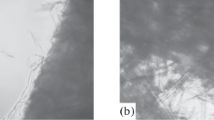Abstract
We have developed several approaches to create cell lines with improved characteristics in cell culture. In some cases it has been possible to isolate natural variants with useful properties. Cholesterol independent variants of the mouse NSO myeloma cell line were isolated by cloning in a selective medium. A glutamine independent variant of a hyridoma was isolated by continuous (chemostat) culture under glutamine limited conditions in the presence of glutamate. Choline independent cells were isolated from a choline limited chemostat. In an alternative approach to modifying cell behaviour, we have used recombinant DNA techniques to introduce the glutamine synthetase (GS) gene to a hybridoma. This resulted in glutamine independence and increased productivity.
Similar content being viewed by others
References
Bebbington CR, Renner G, Thomson S, King D, Abrams D and Yarranton GT (1992). High-level expression of a recombinant antibody from myeloma cells using a glutamine synthetase gene as an amplifiable selectable marker. Bio Technology 10: 169–175.
Bell SL, Bebbington CR, Bushell ME, Sanders PG, Scott MF, Spier RE and Wardell JN (1991). Genetic engineering of cellular physiology. In: Spier RE, Griffiths JB and Meignier B (Eds.) Production of biologicals from animal cells in culture (pp 304–306). Butterworth-Heinemann.
Bell SL, Bushell ME, Scott MF, Wardell JN, Spier RE and Sanders PG (1992). Genetic modifications of hybridoma glutamine metabolism: physiological consequences. In: Spier RE, Griffiths JB and Macdonald C (Eds.) Animal cell technology: developments, processes and products (pp 180–182). Butterworth-Heinemann.
Dykhuizen DE and Hartl DL (1983). Selection in chemostats. Microbiological Reviews 47, 150–168.
Glacken MW, Fleischaker R. and Sinskey AJ (1986). Reduction of waste product excretion via nutrient control: possible strategies for maximising product and cell yields on serum in cultures of mammalian cells. Biotech. Bioeng. XXVIII: 1376–1389.
Griffiths JB (1973). The effects of adapting human diploid cells to grow in glutamic acid media on cell morphology, growth and metabolism. J. Cell Sci. 12: 617–629.
Griffiths JB and Pirt SJ (1967). The uptake of amino acids by mouse cells (strain LS) during growth in batch culture and chemostat culture: the influence of cell growth rate. Proc. Roy. Soc. B. 168: 421–438.
Kawamoto T, Sato JD, Le A, McClure DB and Sato GH (1983). Development of a serum-free medium for growth of NS-1 myeloma cells and its application to the isolation of NS-1 hybridomas. Analytical Biochemistry 130: 445–453.
Lee EU, Roth J, and Paulson JC (1989). Alteration of terminal glycosylation sequences on N-linked oligosaccharides of Chinese hamster ovary cells by expression of β-galactoside α2, 6-sialyltransferase. J. Biol. Chem. 264: 13848–13855.
Li J-L, Li Y-J, Chao S, Lin L-X-M, Ouyang M-H, Pang Y-B and Chang W-S (1991). Cholesterol requirement for growth of 1R983F and P3X63-Ag8-U1 myeloma cells in serum-free medium. Cytobios 68: 15–22.
Pirt SJ (1975). Principles of microbe and cell cultivation. Blackwell Scientific Publications.
Sato JD, Cao H-T, Kayada Y, Cabot MC, Sato GH, Okamoto T and Welsh CJ (1988). Effects of proximate cholesterol precursors and steroid hormones on mouse myeloma growth in serum-free medium. In Vitro Cellular & Developmental Biology 24: 1223–1228.
Schumpp B and Schlaeger E-J (1992). Growth study of lactate and ammonia double-resistant clones of HL-60 cells. In: Spier RE, Griffiths JB and Macdonald C (Eds.). Animal cell technology: developments, processes and products (pp 183–185). Butterworth-Heinemann.
Seaver SS (1992). Enhancing monoclonal antibodies and hybridoma cell lines. Cytotechnology 9: 131–139.
Stephanopoulos G and Sinskey AJ (1993). Metabolic engineering-methodologies and future prospects. Tibtech 11: 392–396.
Author information
Authors and Affiliations
Rights and permissions
About this article
Cite this article
Birch, J.R., Boraston, R.C., Metcalfe, H. et al. Selecting and designing cell lines for improved physiological characteristics. Cytotechnology 15, 11–16 (1994). https://doi.org/10.1007/BF00762375
Issue Date:
DOI: https://doi.org/10.1007/BF00762375




